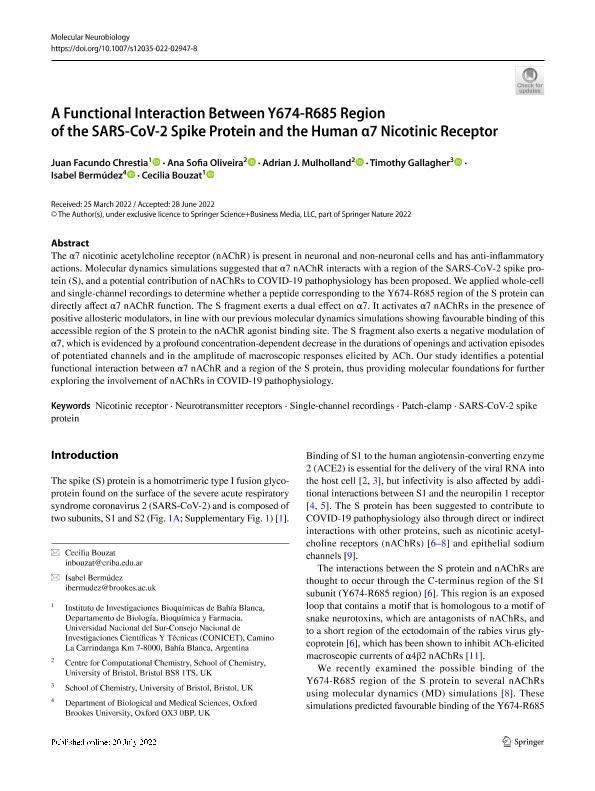Mostrar el registro sencillo del ítem
dc.contributor.author
Chrestia, Juan Facundo

dc.contributor.author
Oliveira, Ana Sofia
dc.contributor.author
Mulholland, Adrian J.
dc.contributor.author
Gallagher, Timothy
dc.contributor.author
Bermúdez, Isabel
dc.contributor.author
Bouzat, Cecilia Beatriz

dc.date.available
2023-07-25T14:42:14Z
dc.date.issued
2022-07-20
dc.identifier.citation
Chrestia, Juan Facundo; Oliveira, Ana Sofia; Mulholland, Adrian J.; Gallagher, Timothy; Bermúdez, Isabel; et al.; A Functional Interaction Between Y674-R685 Region of the SARS-CoV-2 Spike Protein and the Human α7 Nicotinic Receptor; Humana Press; Molecular Neurobiology; 59; 10; 20-7-2022; 6076-6090
dc.identifier.issn
0893-7648
dc.identifier.uri
http://hdl.handle.net/11336/205331
dc.description.abstract
The α7 nicotinic acetylcholine receptor (nAChR) is present in neuronal and non-neuronal cells and has anti-inflammatory actions. Molecular dynamics simulations suggested that α7 nAChR interacts with a region of the SARS-CoV-2 spike protein (S), and a potential contribution of nAChRs to COVID-19 pathophysiology has been proposed. We applied whole-cell and single-channel recordings to determine whether a peptide corresponding to the Y674-R685 region of the S protein can directly affect α7 nAChR function. The S fragment exerts a dual effect on α7. It activates α7 nAChRs in the presence of positive allosteric modulators, in line with our previous molecular dynamics simulations showing favourable binding of this accessible region of the S protein to the nAChR agonist binding site. The S fragment also exerts a negative modulation of α7, which is evidenced by a profound concentration-dependent decrease in the durations of openings and activation episodes of potentiated channels and in the amplitude of macroscopic responses elicited by ACh. Our study identifies a potential functional interaction between α7 nAChR and a region of the S protein, thus providing molecular foundations for further exploring the involvement of nAChRs in COVID-19 pathophysiology.
dc.format
application/pdf
dc.language.iso
eng
dc.publisher
Humana Press

dc.rights
info:eu-repo/semantics/openAccess
dc.rights.uri
https://creativecommons.org/licenses/by-nc-sa/2.5/ar/
dc.subject
NEUROTRANSMITTER RECEPTORS
dc.subject
NICOTINIC RECEPTOR
dc.subject
PATCH-CLAMP
dc.subject
SARS-COV-2 SPIKE PROTEIN
dc.subject
SINGLE-CHANNEL RECORDINGS
dc.subject
COVID-19
dc.subject.classification
Bioquímica y Biología Molecular

dc.subject.classification
Ciencias Biológicas

dc.subject.classification
CIENCIAS NATURALES Y EXACTAS

dc.title
A Functional Interaction Between Y674-R685 Region of the SARS-CoV-2 Spike Protein and the Human α7 Nicotinic Receptor
dc.type
info:eu-repo/semantics/article
dc.type
info:ar-repo/semantics/artículo
dc.type
info:eu-repo/semantics/publishedVersion
dc.date.updated
2023-06-15T17:56:09Z
dc.identifier.eissn
1559-1182
dc.journal.volume
59
dc.journal.number
10
dc.journal.pagination
6076-6090
dc.journal.pais
Estados Unidos

dc.description.fil
Fil: Chrestia, Juan Facundo. Consejo Nacional de Investigaciones Científicas y Técnicas. Centro Científico Tecnológico Conicet - Bahía Blanca. Instituto de Investigaciones Bioquímicas de Bahía Blanca. Universidad Nacional del Sur. Instituto de Investigaciones Bioquímicas de Bahía Blanca; Argentina
dc.description.fil
Fil: Oliveira, Ana Sofia. University of Bristol; Reino Unido
dc.description.fil
Fil: Mulholland, Adrian J.. University of Bristol; Reino Unido
dc.description.fil
Fil: Gallagher, Timothy. University of Bristol; Reino Unido
dc.description.fil
Fil: Bermúdez, Isabel. Oxford Brookes University (oxford Brookes University);
dc.description.fil
Fil: Bouzat, Cecilia Beatriz. Consejo Nacional de Investigaciones Científicas y Técnicas. Centro Científico Tecnológico Conicet - Bahía Blanca. Instituto de Investigaciones Bioquímicas de Bahía Blanca. Universidad Nacional del Sur. Instituto de Investigaciones Bioquímicas de Bahía Blanca; Argentina
dc.journal.title
Molecular Neurobiology

dc.relation.alternativeid
info:eu-repo/semantics/altIdentifier/url/https://link.springer.com/article/10.1007/s12035-022-02947-8
dc.relation.alternativeid
info:eu-repo/semantics/altIdentifier/doi/http://dx.doi.org/10.1007/s12035-022-02947-8
Archivos asociados
